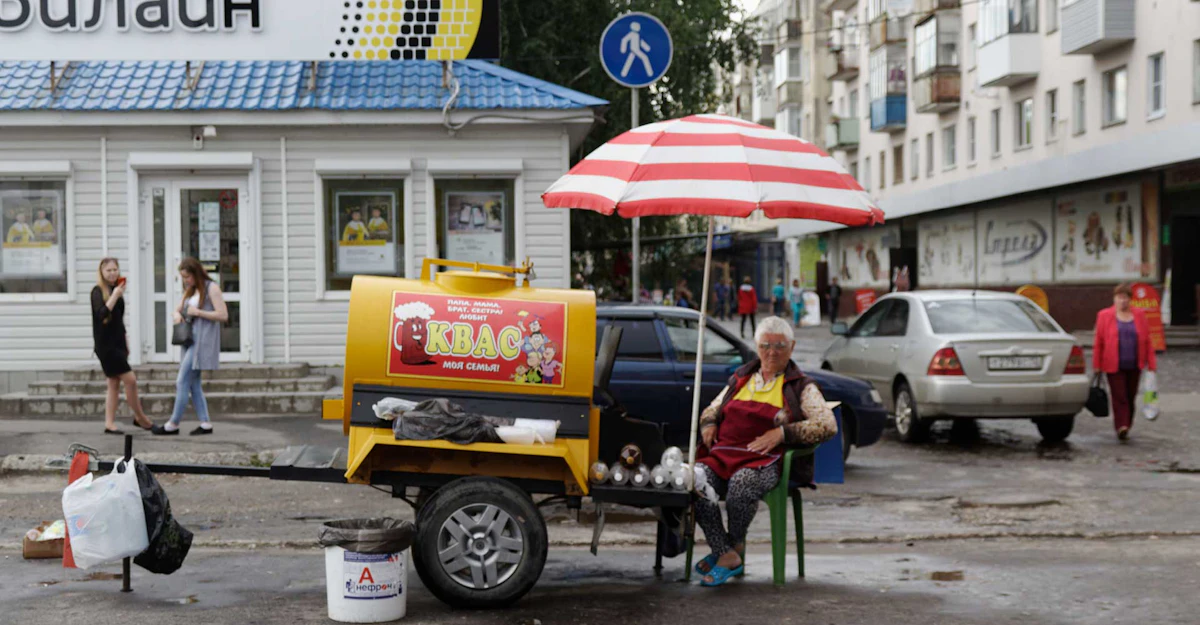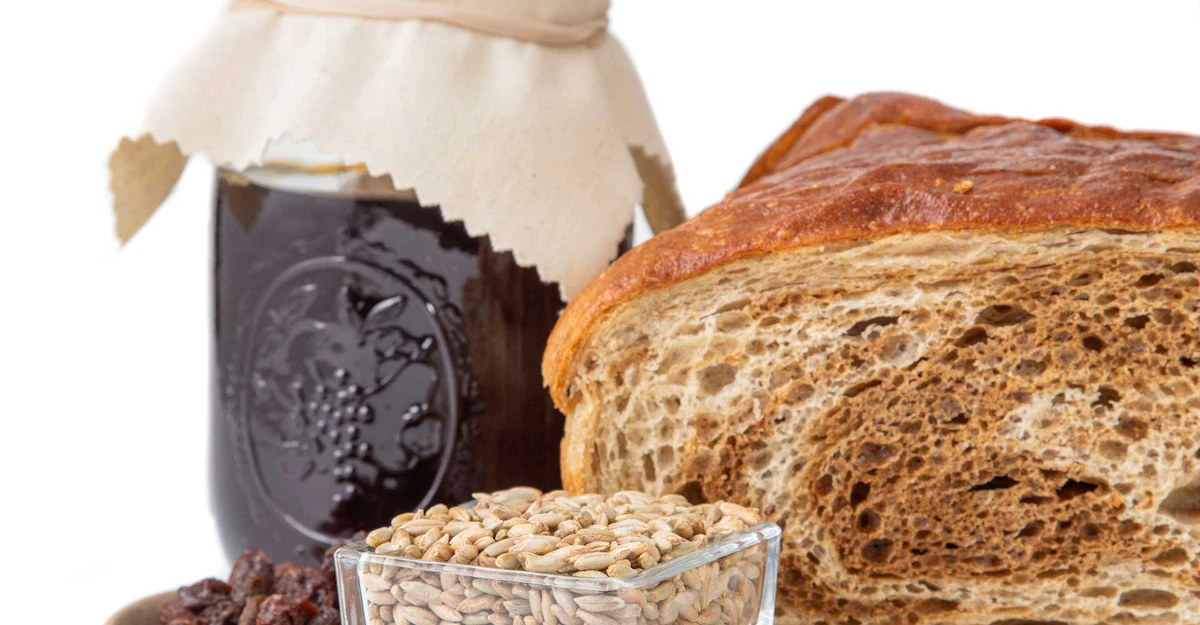Out in the Lithuanian countryside, I’m sitting outside a barn that’s been converted into a small brewery. We’ve come to visit the legendary farmhouse brewer Ramūnas Čižas—but before serving us beer, he brings his gira, which is the Lithuanian word for kvass.
The first sip immediately transports me to my childhood home in Norway—not because I grew up drinking kvass, but because it tastes precisely like my mother’s home-baked bread. Stunned, I sip the drink and explore its flavor nuances: It’s faintly sweet, and the aromas are so transparent, bright, and fresh that it really is like drinking a still-steaming, freshly baked loaf of bread.
“Now you know what real kvass is,” my guide says.
As simple to brew as it is delicious, kvass is a marvel of a drink—even if it doesn’t get you drunk. Unfortunately, outside most of Eastern Europe, it’s little known and even less understood. Most of those who’ve heard of it may think of it as a Russian beer style made from bread. That’s not right, but it’s not completely wrong, either.
What Kvass Is (and Isn’t)
Kvass is not beer because it’s not mashed, and the fermentation is lactic rather than alcoholic. In fact, the root of the word kvass refers to souring. In Eastern Europe, it’s generally considered nonalcoholic, although there can be a little alcohol in it. The Russian national standard for kvass describes it as up to 1.2 percent ABV, “a result of incomplete alcohol and lactic fermentation.”
People sometimes confuse kvass with Lithuanian keptinis, but the two are radically different. Typically, you would make kvass from bread and then sour it. Lithuanian brewers make keptinis wort from a malt mash that’s been baked—which is very much not bread—and then yeast ferments the wort into beer.
However, kvass does not have to be made from bread. Some recipes make it from flour or, to some extent, even malt. More exotic ingredients can include apples, beetroot, horseradish, honey, and so on. (You might think that apple kvass and honey kvass should be considered cider and mead, respectively, but remember: Kvass is about lactic fermentation, not alcoholic fermentation.)
The typical way to make kvass is to simply steep bread in hot liquid for an hour or two, to draw out as much flavor as possible. The bread is usually rye, but wheat bread also works fine. The bread is then sieved out and the liquid cooled until it is ready to receive the culture of lactic-acid bacteria and yeast. You can also use just yeast, if you don’t want it sour; over the past century adding some sugar also has become increasingly common. Then, just let it ferment in the usual way.
You might wonder why anyone would make kvass from bread or flour at all when they could just make beer from the grain instead. The answer is that to make beer, you need quite a lot of grain, but with kvass you can get away with very little. That must have been an easy choice for poor farmers.
Generally speaking, rye—in one form or another—has always been the most important kvass ingredient. There are two likely reasons: First, it’s long been one of the most important grains in Eastern Europe; second, it provides a lot of flavor, which is an important consideration when you’re not using much grain in the first place.

Street vendor with the classic yellow kvass tank, Yoshkar-Ola, Russia. Photo: Lars Marius Garshol
Whose Kvass?
Another way that people often misunderstand kvass is when they describe it as a Russian drink. The reality is more complicated. It’s popular in several countries, and nobody knows who invented it, where, or when.
The first known reference to kvass is in the so-called Tale of Bygone Years, a quasi-historical medieval chronicle. However, the writing of that chronicle dates to 12th-century Kyiv, in what is today Ukraine—and the reference itself is a description of a 10th-century feast there. Moscow didn’t exist yet, and the region where it is now was a backwater province of a large realm with its capital in Kyiv.
Kvass as a drink, however, is assumed to be far older than that document, but nothing more is known about its early history. So, ultimately, we don’t know what ethnicity first came up with the idea. They may well have been Slavs, but not necessarily. There is a closely related drink farther south, stretching into the Middle East. This is bouza, a sweet-sour drink made from flour. It’s possible that bouza—also a very old drink—is the origin of kvass. But, again, it’s uncertain.
Today, kvass is popular in Belarus, Russia, and Ukraine, but also in other places. The Finns and Estonians drink it, but under different names: kalja and kali. It’s also popular in Latvia and Lithuania, to the extent that its name in each country simply means “drink”—in Lithuania it’s gira, and in Latvia it’s dzersis.
Zooming out a bit, it becomes clear that kvass is a key part of the cuisines in large chunks of Eastern Europe, and it would be fair to describe it as the national drink of several of these countries. Historically, it was made on most farms. Later, it was made in hospitals, in army camps—in fact, people made it pretty much anywhere there was a large household that needed something to drink.
The motivation for making kvass was the need to have something besides water to drink. Many people in Eastern Europe chose to make a lot of nonintoxicating kvass rather than a little bit of beer, so that they could have kvass as an everyday drink. It’s unclear whether that was because people thought water wasn’t safe to drink, or simply because they got tired of drinking water all the time.
The Daily Liquid Bread
My research on this is incomplete, but it appears as if you could divide grain-growing Northern Europe into three zones, each with a different daily drink, historically: In the eastern zone, it was kvass; in the west, beer; and in the north, a strange, milky, sour drink called blaand.
Modernization changed all that, of course, and suddenly drinks such as tea, coffee, milk, and fruit juice became widely available. That transformed modern people’s relationships with drinks, to the extent that people today find it almost impossible to fathom the situation in the late 19th century. In many ways it’s as if our own relationship with drink—alcoholic and nonalcoholic—still hasn’t settled into a stable pattern.
However, kvass hung on, and factories in the Soviet Union made vast amounts of it on an industrial scale. Unfortunately, that type of kvass was sweet—sometimes cloying—and mostly artificial, something like a rye-flavored Coca-Cola. You can still find that kind of kvass in supermarkets all over Eastern Europe, and that’s led many people to think of it as a kind of soft drink.
The classic way to sell this kvass was from little yellow tank wagons towed by a car, dispensing cheap kvass in the street to anyone who was thirsty. Those street vendors were once ubiquitous in the summertime all over the Soviet Union, but they are now becoming rare.
You can find better stuff in cafés, brewpubs, and restaurants where the staff make it themselves. However, the real kvass is what’s made out in the countryside, usually by old grandmothers. They have lactic kvass cultures that they maintain from one batch to the next, and they tend their fermentors almost as they would living pets, moving them from room to room to keep the fermentation temperature just right. For Eastern Europeans, kvass has strong associations with the countryside, home, and family. It’s a world that’s hard to access for Westerners, which of course is one reason kvass is so little known here.

Photo: Matt Graves
The Present and Future of Kvass
Kvass really ought to be in fashion because it combines several trends that are popular right now, such as no- or low-alcohol drinks and the sustainable use of food waste (i.e., discarded bread). Done right, it’s also as traditional and authentic as you can get.
Breweries that use leftover bread as an ingredient in beer often make the news, but it’s rare to see one of these stories mention kvass as a related product. (Ours did; see “Special Ingredient: Brewing with Bread,” beerandbrewing.com.) The reason kvass remains out of fashion in the West is that few know much about it—and of those who do know about it, very few have tried a genuine kvass because it’s mainly been made in Eastern Europe.
Tasting real kvass in Eastern Europe requires some dedicated hunting, but it’s not that hard with a little effort—under normal conditions. Tragically, today, much of the drink’s heartland is locked in the grip of imperialist war and fascist dictatorship.
Still, authentic kvass can be found if you’re willing to stray from the well-trodden path. However, unlike beer, its presence tends to be low-key and little advertised. You have to go into unlikely places and really seek it out. Persistence will pay off, eventually, often in unexpected places.
Twenty years ago, for example, I used to drink it in the lunch canteen at Nokia headquarters outside Helsinki—but I didn’t quite realize what it was. Later, I discovered that Finnish gas stations and roadside tavernas often have it. Restaurants serving traditional Finnish food are another good place to look.
It’s a similar story in Lithuania. Some brewpubs have it, but don’t expect to find it in modern craft brewpubs or beer bars. In old-town Vilnius there’s an old-fashioned café that looks like it’s from the 1930s, and a good homemade kvass hides in plain sight at the bottom of the drink menu. Soviet-era milk bars, old-fashioned brewpubs, vintage cafés, university canteens, and family homes in the countryside—those are the sorts of places where you can hope to find a good kvass.
Kvass is still very much alive, but it’s such an everyday drink, so much taken for granted, that it blends into the background. It’s a shame, because at its best it’s magnificent—the perfect summer tipple for when you want to stay clear-headed after a pint or two. My hope is that, one day, Eastern Europeans will understand what a treasure this drink is, so they can bring it back into fashion.
And—who knows?—maybe one day it will catch on here in the West, too.
